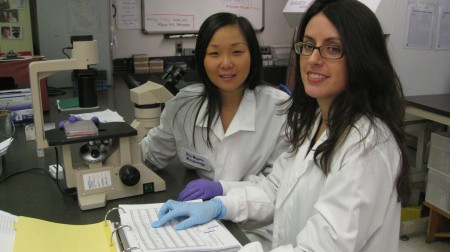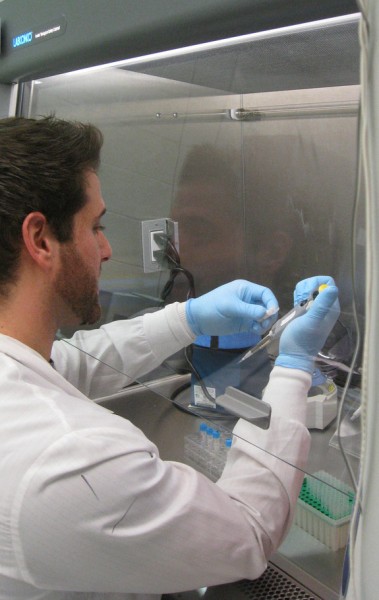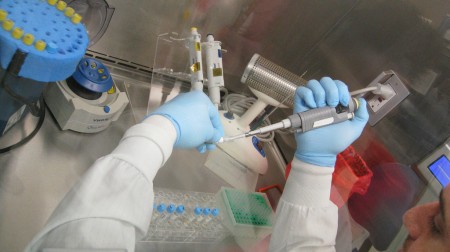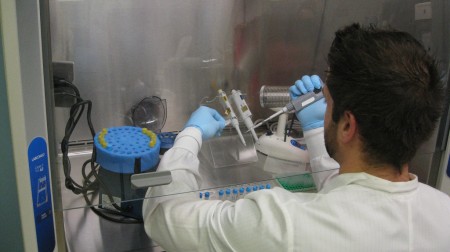 Effective January 19, 2010, the Microbiology Laboratory will discontinue the C difficile two-step algorithm and instead test all appropriately submitted specimens by PCR alone using the BD-GeneOhm™ C diff real-time PCR assay. What will be different?
Effective January 19, 2010, the Microbiology Laboratory will discontinue the C difficile two-step algorithm and instead test all appropriately submitted specimens by PCR alone using the BD-GeneOhm™ C diff real-time PCR assay. What will be different?
- Rejection of specimens that are not liquid or soft (take the shape of the container)
- Testing will be restricted to one specimen in 7 days.
- No more antigen results.
- The Laboratory will no longer call to notify providers of positive results.
- Faster time to results because of twice daily testing.

Kari and Angela – Molecular Virology staff reviewing C. difficile cytotoxin plate
Please read on for more details
Clostridium difficile continues to challenge clinicians, epidemiologists, and microbiologists. It is the cause of 15-25% of cases of antibiotic-associated diarrhea and about 95-100% of cases of antibiotic-associated pseudomembranous colitis (1). C difficile infection (CDI) has increased substantially in the last decade, with the greatest increases observed among elderly populations. In addition, the emergence of severe and fatal disease among otherwise healthy persons with minimal risk factors has also been reported (2).
There are likely many reasons for the increase in incidence, including an aging population, widespread use of broader spectrum antimicrobials, and the emergence of strains such as Nap1 (toxinotype III) that are more virulent. Nap1 has been shown to be quinolone-resistant and to have deletions in regulatory genes (tcdC) that result in more toxin production (1). There is also data to suggest that Nap1 produces more spores and hence may be more transmissible in hospitals and other healthcare facilities (3).
Recently it was reported that toxin B seems to be essential for CDI and not toxin A as previously thought (4). Toxin A-, B+ strains do cause significant disease and, while rare in the U.S., have caused outbreaks in other countries. To date there are rare cases of Toxin A only positive strains.
Patients with CDI almost always have diarrhea, defined as at least 3 unformed or watery stools in a 24-hour period. Most patients have more than 3 episodes of watery, foul-smelling, stools per day. Other clinical features consistent with CDI include abdominal cramps, fever, leukocytosis, and hypoalbuminemia (1).
Suspected cases of CDI should be placed on contact isolation per the JHH HEIC policy. Ideally, the patients should be placed in single rooms.
There are a variety of tests available for the laboratory confirmation of CDI (1, 5-9). These are listed in Table 1 and include enzyme immunoassays (both solid phase and rapid immunochromatographic card tests); cell culture cytotoxicity neutralization assays; anaerobic culture; tests for glutamate dehydrogenase (GDH) antigen followed by a toxin test (two-step algorithm); and most recently, nucleic acid amplification testing. The sensitivities of these methods are quite variable (see Table 1) and can be as low as 65% especially when compared to anaerobic culture. Some of the assays also have poor specificity.
In 2005, the JHH Clinical Microbiology abandoned EIA testing because of poor performance and implemented a two-step algorithm based on screening for GDH and testing positives for toxin using a cell culture neutralization assay. Based upon data at the time, the sensitivity and negative predictive value were 93.4% and 99.2%, respectively (5). There were some drawbacks to this algorithm. While negative results were available the same day of testing, it could require 48 hours to determine the presence of toxin. Over time, the sensitivity of the antigen test seemed to decline, an observation also made by other laboratories, to about 80-85%. In June 2009, the cell culture component of the two-step algorithm was replaced with a nucleic acid amplification test. Now however, effective January 19, 2010, we will no longer screen with the GDH assay and all samples will be tested by the BD-GeneOhm™ C diff real time PCR assay.
The Microbiology Laboratory has considerable experience with all methods of C difficile testing including participation in two FDA clinical trials for molecular assays based on detection of the toxin B gene. The current molecular assay in use at JHH is the BD-GeneOhm™ C diff assay (7). It qualitatively detects conserved regions of the toxin B gene (tcdB). Bacterial DNA is extracted manually using a proprietary sample buffer and lysis tube containing glass beads. The assay has a built-in internal control; amplified targets are detected by molecular beacons. Amplification, detection, and assay interpretation are performed on the SmartCycler® instrument (Cepheid Diagnostics). Time to results requires 90-150 minutes depending upon the number of samples (7). This assay has been extensively evaluated in the literature and all reports corroborate our published findings of sensitivity ranging from 85% to 96% depending upon the comparative methods (7-10). Because of the enhanced sensitivity of PCR, duplicate testing is not necessary nor is it recommended (11). Therefore, testing will be restricted to one specimen within 7days. Call the Laboratory Medicine resident or faculty person on call for those rare instances when a second specimen is required.

Louis – C. difficile PCR extraction
Specimen Collection and Transport
Only patients with diarrhea should be tested for CDI. Stool specimens should be collected in a clean container with a secure lid, labeled, and sent to the laboratory as soon as possible after collection. Mixtures of urine and stool from a bedpan should not be submitted for testing. Specimens that are liquid or soft, that is, take the shape of the container are acceptable. Specimens that are formed or hard (“moon rocks”) will be rejected. Patients may be colonized with toxin-producing C difficile strains that are not causing active disease; therefore it is not recommended that formed stool be tested or that positive results on formed stool be treated. Such treatment has not been demonstrated to prevent subsequent CDI and may even lead to the development of CDI as therapy with both metronidazole and oral vancomycin have been associated with CDI. Rectal swabs and fluid obtained at colonoscopy are not acceptable. The latter can be tested by the cell culture neutralization assay if necessary, but results may be falsely negative due to the prep used for the procedure.

Louis – Preparing stools for PCR
Testing schedule
Specimens will be tested twice daily Monday-Friday and once daily on the weekends. Results from the morning run will be available around 1 PM. Results from the evening run will be available after 7 PM. Because the PCR assay is more sensitive than EIA and the two-step algorithm, duplicate testing is not necessary. Therefore duplicate specimens submitted within 7 days will be canceled.

Louis – Pipetting nucleic acid for PCR
Results and Interpretation
The PCR assay detects the toxin B gene. Therefore the reports will read Positive or Negative for the toxin B gene. The laboratory will no longer call the results so that we can focus on twice daily testing and rapid results. Those units that would like to be notified for infection control purposes can arrange to have electronic notification through Theradoc as soon as results are reported. Please contact HEIC at 5-8384 for more information. Patients who are found to be positive for C difficile must be placed on contact precautions.
In summary, effective January 19, 2010 the laboratory will abandon the C difficile two-step algorithm and proceed with direct PCR testing on all appropriately submitted specimens. Please note the following changes.
- Rejection of specimens that are not liquid or soft (take the shape of the container)
- Testing will be restricted to one specimen in 7days. Call the laboratory medicine resident or faculty person on call for those rare instances when a second specimen is required.
- The laboratory will no longer call the results.
- Faster TAT as a result of twice daily testing.
Table 1. Published Performance of Various C difficile Testing Methods
| Method | Sensitivity
(%) |
Specificity
(%) |
| Enzyme Immunoassays | 33-97 | 83-100 |
| Cell culture neutralization | 65-80 | 97-98 |
| Glutamate dehydrogenase* paired with toxin testing (2-step algorithm) | 80-98 | 96-98 |
| Anaerobic toxigenic culture | >90 | 96-97 |
| Nucleic acid amplification | 88-96 | 94-100 |
*NPV 99% See references 1, 5-9.
Written by:
Karen C. Carroll, M.D.
Professor of Pathology and Medicine
Director, Division of Medical Microbiology
The Johns Hopkins University School of Medicine
References
- Bartlett JG and Gerding DN. 2008. Clinical recognition and diagnosis of Clostridium difficile infection. Clin Infect Dis 46(Suppl 1):S12-S18.
- Centers for Disease Control and Prevention. 2005. Severe Clostridium difficile-associated disease in populations previously at low risk-four states, 2005. MMWR Morb Mortal Wkly Rep 54:1201-05.
- Akerlund T, Persson I, Unemo M, et al. 2008. Increased sporulation rate of epidemic Clostridium type 027/NAP1. J Clin Microbiol 46:1530-33.
- Lyras D, O’Connor JR, Howarth PM et al. 2009. Toxin B is essential for virulence of Clostridium difficile. Nature 458:1176-9.
- Ticehurst, JR, Atird DZ, Dam LM, et al. 2006. Effective detection of toxigenic Clostridium difficile by a two-step algorithm including tests for antigen and cytotoxin. J Clin Microbiol 44:1145-49.
- Stamper PD, Alcabasa R, Aird D, et al. 2009. Comparison of a commercial real-time PCR assay for tcdB detection to a cell culture cytotoxicity assay and toxigenic culture for direct detection of toxin-producing Clostridium difficile in clinical samples. J Clin Microbiol 47:373-8.
- Kvach EJ, Ferguson D, Riska PF and Landry ML. 2009. Comparison of BD GeneOhm Cdiff real-time PCR assay with a two-step algorithm and a toxin A/B ELISA for diagnosisi of toxigenic Clostridium difficile infection. J Clin Microbiol Oct 2009; Epub ahead of print
- Eastwood K, Else P, Charlett A, Wilcox M. 2009. Comparison of nine commercially available Clostridium difficile toxin detection assays, a real-time PCR assay for C difficile tcdB, and a glutamate dehydrogenase detection assay to cytotoxin testing and cytotoxigenic culture methods. J Clin Microbiol 47:3211-7.
- Terhes G, Urban E, Soki J et al. 2009. Comparison of a rapid molecular method, the BD Gene-Ohm Cdiff assay, to the most frequently used laboratory tests for detection of toxin-producing Clostridium difficile in diarrheal feces. J Clin Microbiol 47:3478-81.
- Peterson LR and Robicsek A. 2009. Does my patient have Clostridium difficile infection? Ann Intern Med 151:176-9.
I have a question about how the decision to only repeat C diff testing every 7 days was made. I see on your website that there is a reference (11) cited after this statement, but the listed references stops at 10. We’ve recently started performing C diff by PCR here about 6 months ago and we have testing guidelines very similar to the one you have, but we are getting some resistance from some physicians demanding that they submit a stool specimen every 24 hours for 3 days (like they did when we were using the EIA method). I know that this is of little to no use, but I need documentation stating this. I would appreciate any guidance you could give me on this matter.
Thank you,
Melissa Carter MT, ASCP